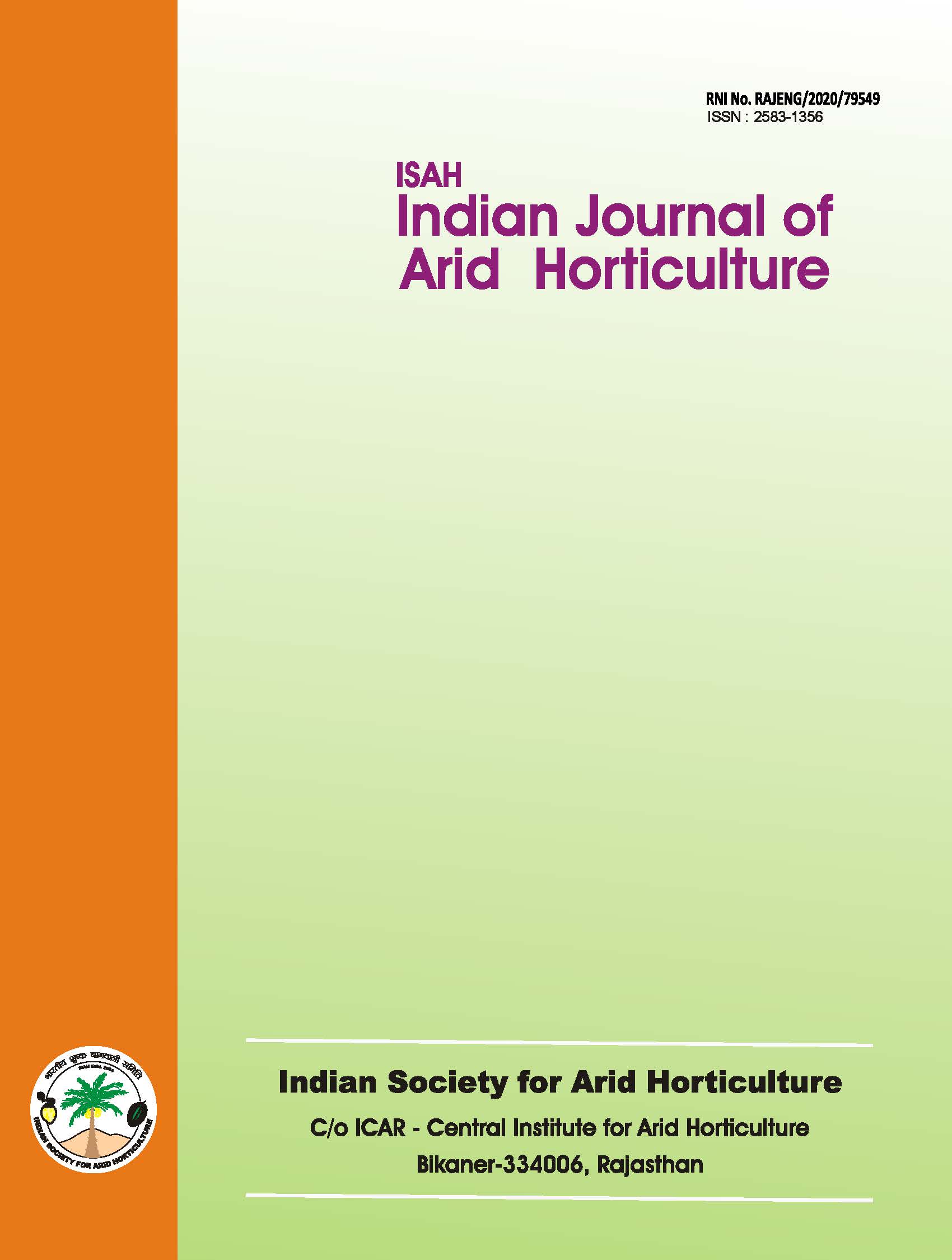Biodiversity in arid fruit crops: A review
DOI:
https://doi.org/10.48165/ijah.2024.6.2.1Keywords:
Biodiversity, arid fruits, selection, variabilityAbstract
Hot arid regions are confronted with climatic adversities besides lack of sufficient irrigation water availability. However, there are numerous fruit species which have inbuilt mechanism to sustain under inhospitable edaphoclimatic condition with available rainfall. The fruits like ber, deshi bordi, jhar ber, khejri, ker, pilu, etc. have been grown successfully under natural condition without irrigation. In some pockets (10-12%), where irrigation water is available either by canal system or underground tubewel, cash crops like date palm, pomegranate, fig, aonla, citrus fruits, etc. are some of the successful ventures by the farmers. The available natural biodiversity present in these fruit crops have been successfully employed to develop high yielding improved varieties mostly by selection from seedling population. The development of clonal propagation techniques enabled perpetuation of developed varieties without the loss of original quality. The strengthening of R&D in ICAR institutes and SAUs further helped in the development of location specific agro-techniques, which led to yield enhancement and post-harvest value addition in typical arid fruit crops. This review article highlights the availability of biodiversity and varietal development in arid fruit crops.
Downloads
References
Anonymous. 2007. Annual Progress Report. CAZRI, Jodhpur. Pp. 40-41.
Anonymous. 2008. Annual Progress Report. CAZRI, Jodhpur. Pp. 46.
Anonymous. 2023. Annual Report. ICAR-CIAH, Bikaner. P. 4. Anonymous. 1994. Annual Progress Report. CAZRI, Jodhpur. Pp. 38-39.
Anonymous. 2020. Annual Progress Report. CAZRI, Jodhpur. Pp. 56.
Anonymous. 2023. Annual Progress Report. CAZRI, Jodhpur. Pp. 61-62.
Bankar, G.J. and Prasad, R.N. 1992. Sushka Kshetron Main Kronda Ki Bagwani. Udyan Lok, 4(2): 13-15.
Bankar, G.J., Verma, S.K. and Prasad, R.N. 1992. Vegetative and fruit characteristics of some Carissa species in the Thar Desert. Progressive Horticulture, 25(3):7-9.
Gauri Shankar 1985. Phalsa. In: Fruits of India Tropical and sub-tropical. T.K. Bose (Ed.). Naya Prokash, Calcutta. Jindal, S.K., Singh, M. and Sivadashan, R. 2006. Variability for seed size, oil content, seed germination and juvenile traits in germ plasm collection of Salvodora oleoides Decne. collected from arid parts of Gujarat. Annals of Arid Zone, 45(1):53-58. Karale, A.R., Keskar, B.G. Shete, M.B. Dhawale, B.C. Kale, P.N. and Chaudhari, K.G. 1989. Seedling selection in Karonda (Carissa carandas L.). Maharashtra Journal of Horticulture, 4: 125-129. Kaul, K.K. Parida, A. Bist, M.S. and Raina, S.N. 1991. Variability
in Prosopis cineraria from India’s Thar Desert. Agro Forestry Today, 3(4):14.
Kaushik, R.A. and Dwivedi, N.K. 2004.Genetic diversity in laso ra. Indian Horticulture, 49(2):27-28.
Khoshoo, T.N. and Singh, N. 1963. Cytology of north-west Indian trees, Ziziphus jujuba and Z. rotundifolia. Silvae Genetica, 12 Heft. Pp. 141-180.
Lal, G. 2002. Evaluation of bael germplasm in semi-arid regions of Rajasthan. Current Agriculture, 26(1-2):127-129. Malik, S.K., Chaudhury, R., Dhariwal, O.P. and Bhandari, D.C. 2010. Genetic Resources of Tropical Underutilized Fruits in India. NBPGR, New Delhi. P. 168.
Meghwal, P.R. 2018. Collection, evaluation and improvement of some underutilized fruits in hot Indian desert. ISAH Indian Journal of Arid Horticulture, 13(1&2):59-64.
Meghwal, P.R. and Azam, M.M. 2004. Performance of some aonla cultivars in arid regions of Rajasthan. Indian Journal of Hor ticultre, 61(1): 87-88.
Meghwal, P. R. and Singh, Akath and Singh, S.K. 2019. Maru Gau rav: New karonda variety. Indian Horticulture, 64(2): 30-31. Mehra, K.L. and Arora, R.K. 1982. Plant Genetic Resources of India-Their Diversity and Conservation. NBPGR, New Delhi. Muthana, K.D. 1980. Silvicultural aspects of khejri. In: Khejri - In the Indian Desert. Mann and Saxena (Eds.). CAZRI, Jodhpur. Pareek, O.P. and Vashishtha, B.B. 1986. Vegetative and fruit char acteristics of ber cultivars of Rajasthan. Annals of Arid Zone, 25(3):214-221.
Prasad, R.N. and Bankar, G.J.2000.Evaluation of pomegranate cultivars under arid conditions. Indian Journal of Horticul ture, 57(4):306-308.
Saroj, P.L., Raturi, G.B. Vashishtha, B.B. and Vishal Nath. 2001. Biodiversity and utilization of khejri (Prosopis cineraria) in western arid zone of Rajasthan. In: Proceeding of National Conference on RCWM at CSWCRTI, Dehradun during 23-25 May, 2001. Pp. 121-129.
Sayed, S., Ramdas, S., Nanjan, K. and Muthuswami, S. 1985. YCD-a Pomegranate. South Indian Horticulture, 33(1):67. Singh, B.P. and Rana, R.S. 1993. Advances in Horticulture (Vol.
I). K.L. Chadha and O.P. Pareek (Eds.). Malhotra Publishing House, New Delhi.
Singh, D. Singh, S. and Saroj, P.L. 2018. Improvement of fruit crops suitable for arid and semi-arid regions. In: Saroj, P.L., Bhargava, R., Sharma, B.D., Singh, D. and Singh, S. In: Sou venir of National Conference on Arid Horticulture for enhanc ing Productivity and Economic Empowerment. ICAR-CIAH, Bikaner. Pp. 46-50.
Singh, H.B. and Arora, R.K. 1978. Wild edible plants of India. ICAR, New Delhi.
Singh, I.S., Srivastava, A.K. and Singh, V. 1999. Improvement of some under-utilized fruits through selection. Journal of Ap plied Horticulture, 1: 34-37.
Singh, M., Jindal, S.K and Sivadashan, R. 2007. In situ variability in morphological and fruit related traits of Capparis decidua (Forsk) Edgew. in arid and semi-arid tracts of Rajasthan and Haryana. Annals of Arid Zone, 46(1):83-90.
Singh, R. 1969. Fruits. National Book Trust of India. New Delhi. Singh, S. and Singh, A.K. 2005. Genetic variability in jamun (Syzygium cuminii Skeels) in Gujarat. Progressive Horticul ture, 37: 44-48.
Singh, S. Singh, A.K., Apparao, V.V. and Bhargava, R. 2015. Thar Kamal: New karonda variety. Indian Horticulture, 60(4): 9-10.
Singh, A. and Meghwal, P.R. 2020. CAZRI Vishal-New pome granate variety. Indian Horticulture, 65(2):24-26.
Vashishtha, B.B., Samadia, D.K. and Nallithambi, P. 2003. Genet ic diversity in pomegranate germplasm in arid regions. In: Human Impact on Desert Environment, Pratap Narain, Kath ju, S. Kar, A., Singh, M. P. and Kumar, P. (Eds.). Scientific Publishers, Jodhpur. Pp. 461-464.
Watt, G. 1893. A Dictionary of Economic Products of India. Vol. VI, Part IV. Cosmos Publication, Delhi. Pp. 366-374. Mahla, H.R. and Singh, J.P. 2013. Assessment of in-situ variability in kair (Capparis decidua) germplasm for utilization in genet ic improvement through ex-situ Conservation. Annals of Arid Zone, 52(2):109-112.

